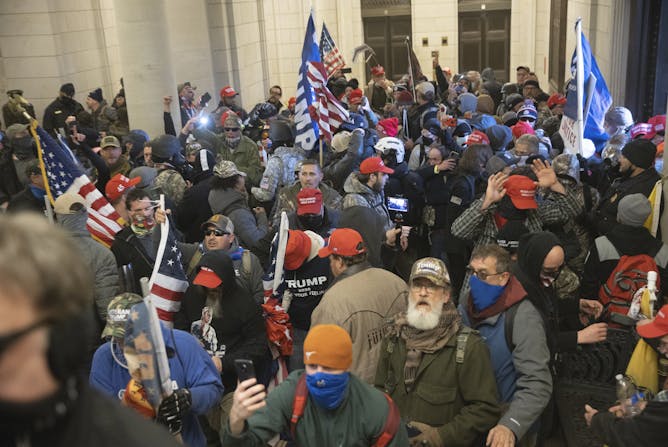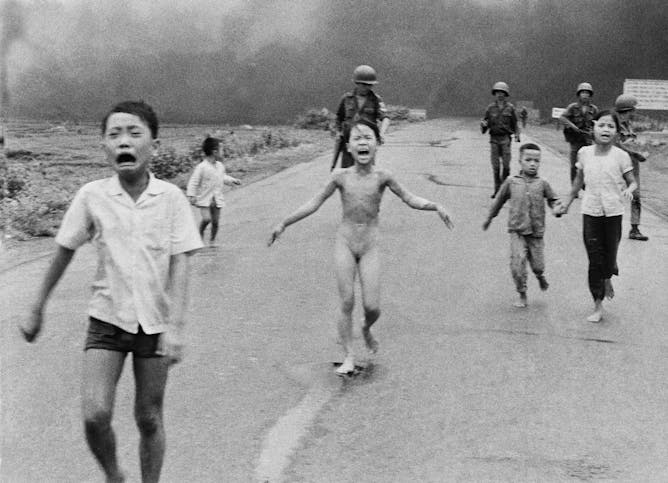|
This past week, our coverage has ranged from a story that busts the myths that grew around the “Napalm Girl” photo published 50 years ago to an analysis of the proposed new names for military bases currently named in honor of
Confederate generals.
In between, we’ve had stories about the status of migration into the U.S., how the number of candidates in primaries has been growing since 2010 – good for extremists, bad for voters – and what circumstances trigger the state trigger laws limiting abortion.
But honestly, much of our attention this week has been on the House Jan. 6 committee hearings that begin tonight.
Desk editors started work late today, in anticipation of a late night covering the hearing for our readers. We’ve lined up almost a dozen scholars to provide analysis throughout the entire series of hearings. Tonight, we have a panel of three giving their learned takes: political scientist Claire Leavitt, who was once a staffer on the House Oversight Committee; philosopher Mark Satta, who is also a lawyer and a specialist in the First Amendment; and scholar Ken Hughes, who has spent over two decades unearthing the secrets of the Nixon, Johnson and Kennedy White House tapes.
We’ll be fueled tonight both by coffee and the understanding that we’re helping chronicle historic government proceedings. The story will publish late tonight; you’ll probably read it while we’re sleeping in tomorrow.
|

Pro-Trump protesters approach the entrance to the U.S. Capitol on Jan. 6, 2021.
Win McNamee/Getty Images
Claire Leavitt, Grinnell College
On the eve of public hearings held by Congress’ January 6 investigative committee, a former oversight staffer for the House of Representatives explains what such hearings aim to accomplish.
|

Terrified children, including 9-year-old Kim Phuc, center, near Trang Bang, Vietnam, after a South Vietnamese plane on June 8, 1972, accidentally dropped its flaming napalm on its own troops and civilians.
AP Photo/Nick Ut, File
W. Joseph Campbell, American University School of Communication
The ‘Napalm Girl’ photo is much more than powerful evidence of war’s indiscriminate effects on civilians. It also shows how false assertions can get traction in the media.
|

Chairman of the Senate Watergate Committee Sam Ervin sits with Chief Counsel Sam Dash, Sen. Howard Baker, staffer Rufus Edmiston and others as they listen to a witness during the Watergate hearings.
Wally McNamee/CORBIS/Corbis via Getty Images
Jennifer Selin, Wayne State University
The public hearings of the House Jan. 6 investigative committee will deal with unprecedented events in American history, but the very investigation of these events has strong precedent.
|
|
|
-
Matthew Valasik, University of Alabama; Shannon Reid, University of North Carolina – Charlotte
White supremacist groups seek to solidify their control over the US by changing the government, sometimes by violence.
-
Matt Harris, Park University
The number of candidates running in party primaries has ballooned since 2010. That may result in extreme, inexperienced or controversial nominees who do not represent a majority of voters.
-
Jeb Barnes, USC Dornsife College of Letters, Arts and Sciences
In a 6-3 conservative majority, the more important divisions may be among the six Republican-appointed justices.
-
Ashwini Tambe, George Washington University
The shooters in the Buffalo and Uvalde massacres were both 18, and legally purchased assault rifles. This is fueling calls to raise the age when someone can purchase this weapon from 18 to 21.
-
Jack Maguire, Florida International University
The US is convening Latin American countries in Los Angeles this week to discuss major regional issues. An expert explains 3 key things to know about one top concern – migration.
-
Jeff South, Virginia Commonwealth University
One of the last relics of ‘lost cause’ ideology is nearing its end as a federal panel has recommended renaming US military bases now honoring Confederate generals.
|
|